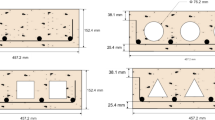Abstract
The main role of mortars in masonry walls is to bind individual units such as brick, stone, and block together, as well as to distribute the stresses uniformly. Knowing the mechanical properties of fresh and hardened mortar is crucial to ensure proper performance of masonry walls and buildings. Water–cement ratio (W/C) and sand grading are among several parameters that affect the behavior of fresh and hardened mortars. This experimental study investigates the effects of common sand grading in Iran and W/C on the flow and workability of fresh mortars and the mechanical properties of hardened mortars. Using fine and coarse sands, cement–sand mortar and cement–lime–sand mortar with three different cement contents were manufactured. Three various W/Cs were considered for each mortar mix; overall, 36 kinds of mortar mixes were studied. Standard samples were tested to determine compressive strength, flexural strength, elastic modulus, and flow of mortars. Results were analyzed to find different practical relationships among compressive strength, flexural strength, elastic modulus, and W/C. Results show that by increasing W/C, usually the strength of the hardened mortar decreases and the flow of the fresh mortar increases. Furthermore, cement–sand mortar with fine sand has less compressive strength, flexural strength, and elastic modules compared to mortar with coarser grading sand. Also, mortar with fine sand needs around 25% more water to attain the same flow and workability compared to the mortar with coarse sand.




















Similar content being viewed by others
References
Abbagana M, Tim GH, Aliyu A (2015) Importance of sand grading on the compressive strength and stiffness of lime mortar in small scale model studies. Open J Civil Eng 5:372–378
Amadio C, Rajgelj S (1999) Shear behavior of brick-mortar joints. Mason Int 5:19–22
Anderson C, Held LC (1986) The effect of sand grading on mortar properties and tensile bond strength of brickwork specimens. Proc Br Mason Soc 1:1–6
Appa Rao G (2001) Generalization of Abrams’ law for cement mortars. Cem Concr Res 31:495–502
ASTM C1437-15 (2015) Standard test method for flow of hydraulic cement mortar. Am Soc Test Mater
ASTM C144-11 (2011) Standard specification for aggregate for masonry mortar. Am Soc Test Mater
ASTM C109-16 (2016) Standard test method for compressive strength of hydraulic cement mortars. Am Soc Test Mater
ASTM C305-14 (2014) Standard practice for mechanical mixing of hydraulic cement pastes and mortars of plastic consistency. Am Soc Test Mater
ASTM C348-14 (2014) Standard test method for flexural strength of hydraulic cement mortars. Am Soc Test Mater
ASTM C469-14 (2014) Test Method for static modulus of elasticity and poisson’s ratio of concrete in compression. Am Soc Test Mater
Atkinson RH, Amadei BP, Saeb S, Sture S (1989) Response of masonry bed joints in direct shear. Struct Eng 115:2277–2296
Binda L, Tiraboschi C, Abbaneo S (1997) Experimental research to characterize masonry materials. Masonry Int 10:592–601
Eurocode6 (1996) Design of masonry structures -part1: rules for reinforced and unreinforced masonry. Eur Stand Code
Haach VG, Vasconcelos G, Lourenco B (2011) Influence of aggregates grading and water/cement ratio in workability and hardened properties of mortars. Construct Build Mater 25:2980–2987
Lawrence SJ, Cao HT (1988) Microstructure of the interface between brick and mortar. In: Proceedings of the eighth international brick/block masonry conference, vol 2. pp 194–204
Maheri MR, Motielahi F, Najafgholipour MA (2011) The effects of pre and post construction moisture condition on the in-plane and out-of-plane strengths of brick walls. Mater Struct 44:541–544
Mazroui A, Yaghoubifar A, Jafarpour F (2012) Experimental study of mechanical properties of common sand and cement mortars (for masonry). Building and Housing Research Center, Tehran
MSJC-13 (2013) Building code requirements and specification for masonry structures, Masonry Standard Joint Committee’s (MSJC) Book
Reddy BVV, Gupta A (2008) Influence of sand grading on the characteristics of mortars and soil–cement block masonry. Construct Build Mater 22:1614–1623
Roberti GM, Binda L, Cardani G (1997) Numerical modeling of shear bond tests on small brick-masonry assemblages. In: Proceedings of the computer methods in structural masonry conference, Florence, Italy, vol 4. pp 145–152
Sébaïbi Y, Dheilly RM, Quéneudec M (2003) Study of the water-retention capacity of a lime–sand mortar: influence of the physicochemical characteristics of the lime. Cem Concr Res 3:689–696
Van Balen K, Van Gemert D (1990) Lime–cement mortars compared to the commonly used cement mortars in Belgium. University of Belgium, Belgium
Venu Madhava Rao K, Venkatarama Reddy BV, Jagadish KS (1996) Flexural bond strength of masonry using various blocks and mortars. Mater Struct (RILEM) 29:119–124
Author information
Authors and Affiliations
Corresponding author
Ethics declarations
Conflict of interest
The authors declare that they have no conflict of interest.
Rights and permissions
About this article
Cite this article
Dehghan, S.M., Najafgholipour, M.A., Baneshi, V. et al. Experimental Study on Effect of Water–Cement Ratio and Sand Grading on Workability and Mechanical Properties of Masonry Mortars in Iran. Iran J Sci Technol Trans Civ Eng 43, 21–32 (2019). https://doi.org/10.1007/s40996-018-0110-7
Received:
Accepted:
Published:
Issue Date:
DOI: https://doi.org/10.1007/s40996-018-0110-7




